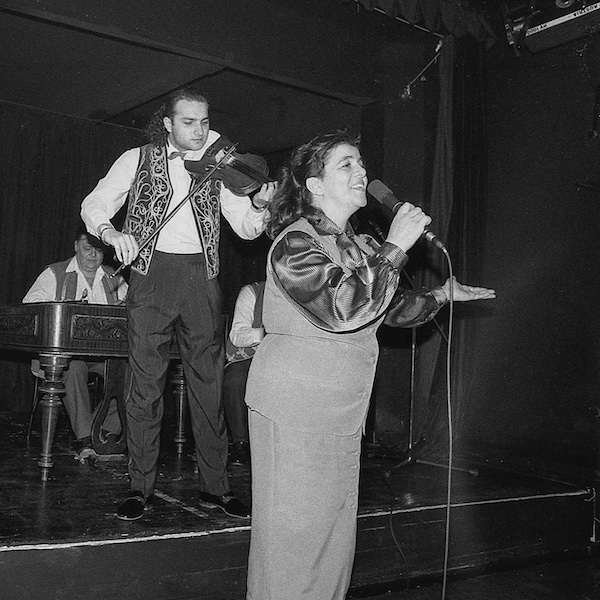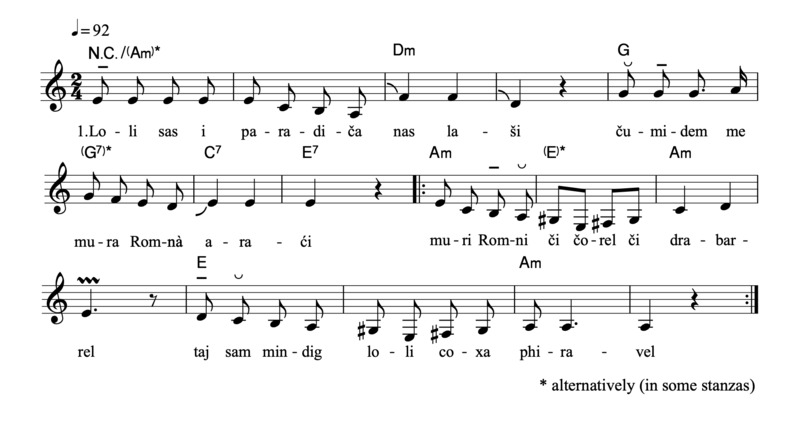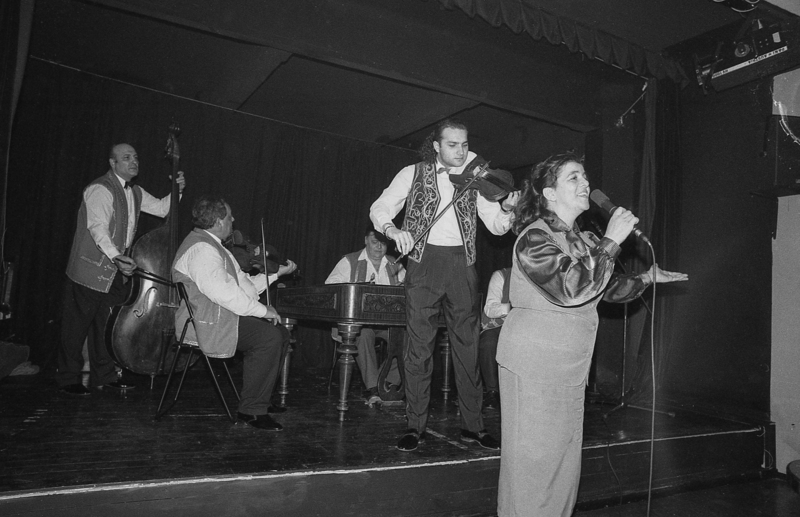
Loli sas i paradiča
Content
Recordings
The dance song Loli sas i paradiča is about a woman who likes to dress in red. The colour red is special for the Roma and stands for joy and happiness.
Musical transcription based on the booklet accompanying the CD Amare gila - Unsere Lieder / Our Songs
Loli sas i paradiča is a dance song that Ruža Nikolić-Lakatos has been familiar with since childhood. The percussion is traditionally drummed with fingers - on table tops, cooking pots and upturned buckets, otherwise used for washing.
Ruža Nikolić-Lakatos and The Gypsy Family published this version of Loli sas i paradiča on their CD E Trin Worbi.
Ruža Nikolić-Lakatos demonstrates the percussion to Loli sas i paradiča. She accompanies herself by drumming on the table with her fingers.
Ruža Nikolić-Lakatos performs Loli sas i paradiča with the Pišti-Horvath-ensemble as part of a performance at the Interkulttheater in 1994. Stefan Pišti Horvath was a world-famous cimbalom player and member of the Roma ethnic group.
Commentary
(GERMAN ONLY) Ruža Nikolić-Lakatos explains the content of Loli sas i paradiča to ethnomusicologist Ursula Hemetek during a field research interview.
(GERMAN ONLY) Ruža Nikolić-Lakatos tells ethnomusicologist Ursula Hemetek about her early memories with the song Loli sas i paradiča. She speaks about the performance context and the creation of dance songs. The singer also explains how the accompaniment to this dance song was traditionally made. The recording is from a field research interview in the Nikolić family home in 1993.
Lyrics
Strophe 1
| Loli sas i paradiča nas laši, | The tomato was red, but it wasn't good, |
| čumidem me mura romnja aratji. | I kissed my wife last night. |
| Muri Romni či čorel, či drabarel | My wife doesn't beg and doesn't tell fortune |
| taj sa mindig loli coxa phiravel. | and she prefers to wear a red skirt. |
Strophe 2
| Loli coxa, lolo gad voj phiradas, | She wore a red skirt and a red shirt, |
| mamo, e šavengo šero dijardas. | and turned the boys' heads. |
| Loli coxa, lolo gad voj phiradas, | She wore a red skirt and a red shirt, |
| mamo, e šavengo šero dijardas. | and turned the boys' heads. |
Strophe 3
| De ma, mamo, panž šelenge te khelav, | Give me, mother, five hundred so that I can play cards |
| mamo, mindig muri voja te kerav. | and can always enjoy myself. |
| Ke muri Romni či čorel či drabarel | Because my wife doesn't steal and doesn’t tell fortune |
| taj sa mindig loli coxa phiravel. | and she prefers to wear a red skirt. |
Videos
Ruža Nikolić-Lakatos and her son Mischa Nikolić at a performance at the University of Music and Performing Arts Vienna for the occasion of the ethnomusicologist and confidante Ursula Hemetek 60th birthday. Ruža publicly congratulates her. Her Parkinson's disease is already strongly visible.
Loli sas i paradiča during a gala concert on the occasion of Ruža Nikolić-Lakatos' 20th stage anniversary at Porgy&Bess in 2011. Together with Ruža, her son Mischa, Christian Vidic, Melinda Stoika and Diknu Schneeberger perform.
Photo
© Mehmet Emir (1994)
Loli sas i paradiča with the ensemble Pišti Horvath at Interkulttheater
Zitierempfehlung anzeigen
Bitte zitieren Sie diese Seite wie folgt:
Music and Minorities Research Center, "Loli sas i paradiča", Ružake gila, zuletzt besucht am Loading date..., doi.org/10.21939/8ca6-j777



